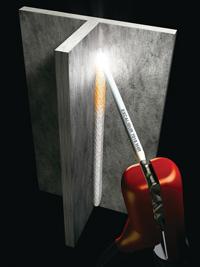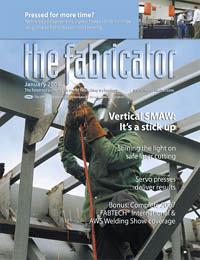- FMA
- The Fabricator
- FABTECH
- Canadian Metalworking
Categories
- Additive Manufacturing
- Aluminum Welding
- Arc Welding
- Assembly and Joining
- Automation and Robotics
- Bending and Forming
- Consumables
- Cutting and Weld Prep
- Electric Vehicles
- En Español
- Finishing
- Hydroforming
- Laser Cutting
- Laser Welding
- Machining
- Manufacturing Software
- Materials Handling
- Metals/Materials
- Oxyfuel Cutting
- Plasma Cutting
- Power Tools
- Punching and Other Holemaking
- Roll Forming
- Safety
- Sawing
- Shearing
- Shop Management
- Testing and Measuring
- Tube and Pipe Fabrication
- Tube and Pipe Production
- Waterjet Cutting
Industry Directory
Webcasts
Podcasts
FAB 40
Advertise
Subscribe
Account Login
Search
Five tips for vertical stick welding
5 tips to get it right when it's needed most
- By Bill West
- Updated October 25, 2023
- January 15, 2008
- Article
- Arc Welding

Figure 1 SMAW, or stick welding, requires a certain mastery of skills, and vertical and overhead stick welding is that much more difficult-one of the reasons the specialty is in such great demand.
Vertical and overhead stick welding have never been in such high demand. Heavy construction continues (seeFigure 1) in the southeast U.S., while the utility industry is busy building new power plants, improving old ones, and repairing refineries hammered by a wave of Gulf Coast hurricanes.
Ironworkers, pipe fitters, boilermakers, and shipbuilders are working to meet a new global demand for development and energy. At the core of this work lies an advanced welding position that requires skill beyond the preferred horizontal position—vertical-up shielded metal arc welding, or stick welding.
Welding in a Vertical Position
Flat and horizontal welding positions lend themselves to faster work, but sometimes vertical or overhead welding with a stick electrode cannot be avoided. If that's the case, here are five tips to help you do it well.
1. Choose the Right Electrode
Fighting gravity is the main challenge in vertical-up welding—or any position that is 45 degrees or steeper. Stick electrodes with an AWS classification of 7018 are considered the first choice because of their low iron powder content (see Figure 2). The molten metal produces a puddle that can freeze quickly and is less inclined to drip off the work during its liquid state.
AWS 6010 also can be used for similar reasons, but 7018 allows a faster weaving pattern. Using 6010 requires a stacking or a whipping technique, where the stick is pulled intermittently in and out of the puddle.
A 6010 electrode will help overcome poor surface conditions, but it takes more time and skill than weaving with 7018. Those new to vertical-up welding sometimes mistakenly choose a 7024, which lacks proper fill and often drips uncontrollably down the work.
2. Create a Weld Shelf
Of the five welding positions—flat, horizontal, overhead, vertical-up, and vertical-down—vertical-up is the slowest because the welder needs to combat gravity. A slow travel speed provides better penetration than vertical-down, so the technique is required on most material thicker than sheet metal.
The trick to both vertical and overhead welding is preventing the puddle from spilling out of the weld. For material thicker than sheet metal, vertical welding generally should be performed uphill. Welding thinner sheet metal can be performed downhill because less penetration is needed, and the faster travel speed produces cooler temperatures that prevent burn-through. But that's a subject for another article.
Vertical-up welding can be compared to bricklaying in that you slowly create a weld base from the bottom up, one small section at a time and continuously working above each previously laid weld. Each newly laid lower weld acts as a base on which subsequent welds are made (see Figure 3). That lower bead is referred to as the shelf.
Each shelf step should be about 1.5 to two times the diameter of the electrode. A 1⁄8-inch electrode needs to create about a 1⁄6- to ¼-in. puddle that freezes in time to uphold the next weld.

Figure 2Stick electrodes classified as 7018 produce a puddle that freezes quickly, which allows for a faster weaving pattern when welding uphill.
When weaving vertically up with a 7018 electrode, zigzag back and forth, and allow each puddle section to freeze in place in time to weld up to the next stair step. Hold the electrode slightly uphill, and keep a short arc to gain better penetration and fusion.
During a weave, focus on welding the sides of the joint. Pause briefly at the sides to allow the bead below to cool and the lower shelf to form. Watch the puddle closely to make sure the slag drips off the shelf. Slag trapped in the weld will impair strength and diminish appearance. If the base metal overheats, the puddle will spill. If you see this start to happen, quickly move the electrode away from the crater without losing the arc.
With a 6010 electrode, a stacking technique replaces the 7018 weave. The stack should resemble poker chips—each chip creating a shelf for the next level. To stack a vertical-up weld, keep the electrode in the root of the material. As the puddle forms, whip the electrode upward, while maintaining the arc. When the puddle freezes, return the electrode and apply another level to the leading edge of the weld. Continue this until the weld is complete. Again, each puddle should be roughly 1.5 to two times the diameter of the electrode.
3. Avoid Undercutting
One error to avoid while weaving is undercutting. This occurs when the work is gouged without sufficient filler metal, as gravity draws the filler metal away from the work. One way to avoid this is by reducing current and slowing the process. Sometimes simply reducing the puddle size improves operator control.
Good out-of-position welders watch the puddle closely. They learn to read its characteristics. In both weave and stacking techniques, the slag should drip off the shelf, while the puddle forms well enough to fill the gouge and stay in place.
4. Use a Low Power Setting
Because a vertical-up puddle needs to freeze quickly and in place, a low amperage setting is needed to maintain control. Welding in the flat position carries the benefit of gravity and can be performed at lower temperatures and faster travel speeds.
In general, use the lower end of an electrode's amperage rating when welding vertically up or overhead. For instance, power to 120 to 130 amps using 1⁄8-in. 7018 electrodes and 90 to 100 amps for 1⁄8-in. 6010 electrodes.
5. Consider Flux-cored Vertical-up Welding
Flux-cored welding has replaced some of the traditional stick welding in many construction markets because of its higher productivity resulting from a continuously fed wire. However, many ironworkers prefer stick, which can be more convenient if the work requires the welder to move around a lot.
For welding extended periods in one place, flux-cored wire might be a good alternative. If that's the case, all the same rules apply for vertical-up welding as the 7018 stick weaving technique. Build a shelf, and weave upward slowly enough to allow the level below to freeze, while not overheating the base metal.
Safety in Vertical Stick Welding
With any out-of-position welding, all of the standard safety precautions that apply to flat and horizontal welding should be increased because of the added risk of falling molten metal and spatter. Safety glasses, a proper helmet, gloves, long sleeves, and leather or fire-retardant clothing are a must (see Figure 4). Safety-toe shoes will help prevent burns.
Becoming certified to weld in a vertical position is a good idea for anyone planning repeated vertical-up welding. Another benefit is that someone certified in vertical welding is automatically certified in flat and horizontal welding.
About the Author
Bill West
22801 St. Clair Ave.
Cleveland, OH 44117
216-481-8100
Related Companies
subscribe now

The Fabricator is North America's leading magazine for the metal forming and fabricating industry. The magazine delivers the news, technical articles, and case histories that enable fabricators to do their jobs more efficiently. The Fabricator has served the industry since 1970.
start your free subscription- Stay connected from anywhere

Easily access valuable industry resources now with full access to the digital edition of The Fabricator.

Easily access valuable industry resources now with full access to the digital edition of The Welder.

Easily access valuable industry resources now with full access to the digital edition of The Tube and Pipe Journal.
- Podcasting
- Podcast:
- The Fabricator Podcast
- Published:
- 04/16/2024
- Running Time:
- 63:29
In this episode of The Fabricator Podcast, Caleb Chamberlain, co-founder and CEO of OSH Cut, discusses his company’s...
- Industry Events
16th Annual Safety Conference
- April 30 - May 1, 2024
- Elgin,
Pipe and Tube Conference
- May 21 - 22, 2024
- Omaha, NE
World-Class Roll Forming Workshop
- June 5 - 6, 2024
- Louisville, KY
Advanced Laser Application Workshop
- June 25 - 27, 2024
- Novi, MI
































